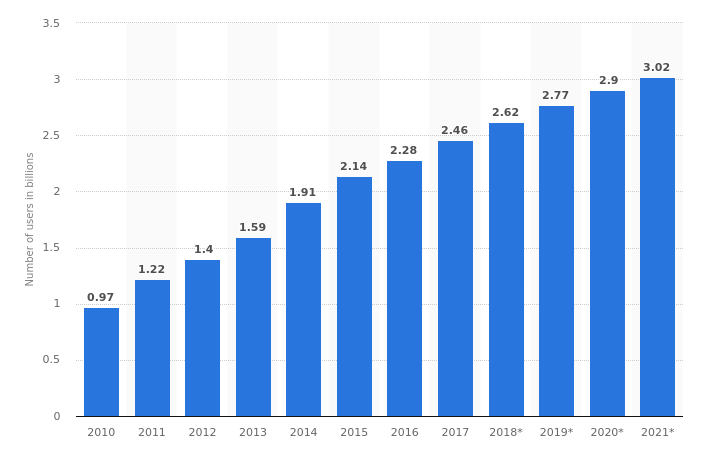Campaigns are an effective way to strengthen customer relationships, expand a brand’s reach, and increase its sales.
Traditionally, marketers used posters, fliers, billboards, banners, newsletters and print advertisements for campaigning. But when it came to measuring a campaign’s success, traditional ways would only prove to give an approximate number.
The success of traditional campaigns was speculated based on the increase in sales, and asking customers to fill out forms with questions like:
Then came social media and the tide turned.
With 2.62 billion social media users worldwide, marketers were drawn to adapt to this platform alongside their traditional methods to carry out their campaigns.

Initially, running a campaign on social media was not scalable, so the traditional way of campaigning was still preferred but now, with social networks having their own analytics, they have become scalable and tactical, allowing you to plan and implement a larger strategy with more complex features such as geotargeting, targeting based on interests and targeting based on previous activity.
Nearly 92% of marketers have agreed that social media is essential for their business and have brought more exposure to their brand.
Around 80% of marketers have experienced a sufficient growth in their website’s traffic through social media. And 72% have been using this platform to develop loyal customers.
That’s how much marketers trust social media platforms for marketing their brand and run campaigns.
But how to measure if a campaign, that you’ve invested so much time in, is successful or not?
The pointers below will give you the answer.
1. Begin with setting up goals
Before jumping off to measuring the likes, retweets, or comments that your post has engaged so far, you need to set goals. You need to decide what your business is trying to accomplish with a campaign.
There can be many goals to your social marketing because businesses can use their social handles for a number of purposes. You can broadcast information, introduce a new product, resolve customer queries, or generate traffic. So, you need to select the relevant goals for each campaign.
You have to decide what you want your audience to do: like, comment, share, or something else. You need to decide if you want to engage with your audience, make them aware of your brand, or gain loyalty.
If you have a clear idea about the goals of your campaigns then the following stages become easier.
2. Decide the relevant metrics
So, now the goals have been set. What next? Should we just begin measuring them? Well, no. You cannot simply begin measuring your goals just after deciding them.
You need to first choose the relevant metrics for efficiently tracking the success of your goals.
For instance, you have uploaded an engaging post, but how would you know if the audience is engaging with it or not? Is it through the likes, the comments, or the shares? What’s the best metric to measure engagement?
In order to determine the best metrics for your campaign, it’s first important to understand the purpose of different types of metrics and what they can measure:
Awareness:
- Reach
- Followers
- Likes
- Impressions
- Hashtags
- Volume
Engagement:
- Comments
- Shares
- Retweets
- Replies
- Hashtags
- Conversation threads
Traffic:
- URL clicks and shares
- Conversions
Advocacy OR Loyalty:
Track mentions and see what is being said about your brand. While tracking them, you will be able to locate loyal customers and brand advocates. You will even be able to track how people are comparing your brand to your competitors.
NOTE: Hashtag is an important element in social media metrics, it can help you measure the reach as well as the engagement of a campaign.
3. Gather the required data
Now, you should begin by gathering the data and, as you have already selected the metrics, you can decide what you need to track.
Social media platforms have their own analytics, such as Facebook Analytics and Twitter Analytics, to compile the required data including likes, shares, reach, impressions, mentions, hashtags etc. You can also use Google analytics to provide you with conversion rates and referrals.
Using these analytics, you will have a detailed account of how your campaign has done. And this takes you to the next step...
4. Analyze the data and see if it matches your goal
After gathering the required data, you must begin analyzing it so that you are able to gauge if the set goal has been achieved or not. Check if your campaign was able to engage your audience or drive traffic to your website, whatever your goal may be.
Start focusing on the comments and mentions to know the mindset of your audience and understand why the campaign was or wasn’t a success. You can also participate in the conversation to get a more accurate idea.
5. Update your marketing techniques and campaigns
Now, the final step is to upgrade.
After analyzing the data, you will have a better understanding of which campaigns your audiences react to best. This may also provide some indication on how you should craft your future campaigns for a better ROI.
As you analyze more data, patterns will emerge. Patterns such as which trends are on a decline, which trends are becoming more popular, which type of content works really well and what type of content evokes a reaction.
All this information you can use to improve your techniques and strategy to create better social campaigns.
Closing thoughts
It real is that simple.
Although, this can be a time consuming process, once you’re able to establish how to implement each step, you can efficiently record and measure the success of every campaign you run on social media.
Access the latest business knowledge in Marketing
Get Access







Comments
Join the conversation...